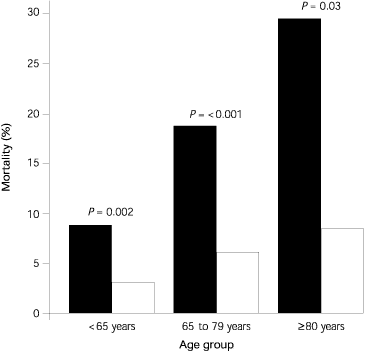
Am Fam Physician. 2003;67(6):1354-1356
Coronary artery disease (CAD) affects persons of all ages, although most new coronary events occur in older persons. Approximately 85 percent of persons who die from CAD are 65 years of age and older. Statin (3-hydroxy-3-methylglutaryl coenzyme A reductase inhibitor) therapy has been proved to reduce cardiovascular mortality in patients with known CAD. Unfortunately, most of the landmark studies have excluded the very elderly (i.e., persons older than 80 years). The relationship between elevated cholesterol levels and mortality rates in the elderly has not been established and, in one study, patients with low cholesterol levels had an increased risk of mortality. As a result of these studies, the use of statins in the elderly with known CAD has lagged behind that in younger patients. Maycock and associates studied the efficacy of statin therapy in three age groups, including the very elderly, with known CAD.
Participants in the study presented to the hospital with symptoms or clinical findings suggestive of CAD and had significant CAD as defined by angiography. The participants were then divided into three age groups: younger than 65 years, 65 to 79 years, and 80 years and older. Statin therapy was determined at the time of discharge from the hospital. Patient information was collected on all participants and included information on age, gender, hyperlipidemia, hypertension, smoking, and cardiac history. The participants were then followed for an average of 3.3 years to determine all causes of mortality.
There were 7,220 participants enrolled in the study, with an average age of 65 years. The overall mortality rate for the group was 16 percent during the study. Mortality rates decreased for all age groups who received statins compared with those who did not. Among patients 80 years and older, the mortality rate of patients taking statins was 8.5 percent, compared with 29.5 percent in those who were not taking statins. In persons 65 to 79 years of age, the mortality rate for those taking statins was 6.0 percent versus 18.7 percent for those not using statin therapy (see the accompanying figure). These reductions were statistically significant. The authors also noted that patients 80 years of age and older were much less likely to be given statin therapy than patients in the younger age groups.

The authors conclude that statin therapy in patients with significant CAD reduces mortality rates even in the very elderly. Although in the study the elderly were much less likely to be given statin therapy than patients younger than 65 years, they received a greater absolute risk reduction than younger persons. The authors add that more aggressive statin therapy should be considered in older patients.
editor’s note: Over the past few years, excellent studies have shown the positive impact statin therapy can have in middle-aged men. Recent studies have expanded our knowledge to include middle-aged women and the “young” elderly. However, the majority of cardiovascular disease occurs in elderly patients. The study by Maycock and associates demonstrates that statin therapy can be beneficial in elderly patients, even those who are older than 80 years. Even patients older than 65 years who were enrolled in this study were not likely to receive statin therapy. This means that efforts should be made to increase the use of statin therapy in our elderly patients.—k.e.m.